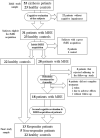Improved cognition after rifaximin treatment is associated with changes in intra- and inter-brain network functional connectivity
- PMID: 38217008
- PMCID: PMC10787503
- DOI: 10.1186/s12967-023-04844-7
Improved cognition after rifaximin treatment is associated with changes in intra- and inter-brain network functional connectivity
Abstract
Background: Rifaximin is a non-reabsorbable antibiotic which acts at gut level, and improves cognition and inflammatory parameters in minimal hepatic encephalopathy (MHE) patients, but not all patients show the same level of response. This study aims to assess brain activity, both within and between brain networks, following rifaximin treatment, considering the differences between response groups as well.
Methods: Twenty-two healthy controls and 53 patients with cirrhosis (22 without and 31 with MHE, diagnosed by Psychometric Hepatic Encephalopathy Score, PHES) performed psychometric, attention and coordination tests, and blood inflammatory parameters were measured. Resting-state functional magnetic resonance imaging (fMRI) acquisitions were performed on controls and MHE patients. Eighteen MHE patients underwent a rifaximin treatment for 6 months, after which all measures were repeated. fMRI images were analysed and changes after treatment were assessed.
Results: After rifaximin treatment, 13 patients improved their PHES score (Responder patients) while 5 did not (Non-responder patients). No significant decrease in blood ammonia was observed after rifaximin treatment, but there was a decrease in plasma inflammatory cytokines in responder patients. A global effect of rifaximin was detected on the sensorimotor and fronto-parietal networks. Responder patients showed a relative increase of thalamic network connectivity in comparison to non-responder patients. Before treatment, responder and non-responder patients showed connectivity differences in basal ganglia network. The connection of the sensorimotor and thalamic networks between them and with other networks suffered changes after treatment. These connections between networks mostly decreased after treatment. All changes and differences showed a significant level of correlation with the performance of psychometric tests and the blood levels of inflammatory biomarkers.
Conclusions: There was an improvement of the communication between executive, motor and attention-related brain areas, and their functional independence following rifaximin treatment. Patients who respond also show a less deteriorated connection involved in these functions before treatment. Results suggest that the improved inflammatory state of MHE patients, following rifaximin treatment would favour the observed changes in brain function and enhanced cognitive performance.
Keywords: Functional magnetic resonance imaging; Minimal hepatic encephalopathy; Psychometric tests; Rifaximin.
© 2024. The Author(s).
Conflict of interest statement
The authors declare no competing interests.
Figures




Similar articles
-
Enhancement of functional connectivity, working memory and inhibitory control on multi-modal brain MR imaging with Rifaximin in Cirrhosis: implications for the gut-liver-brain axis.Metab Brain Dis. 2014 Dec;29(4):1017-25. doi: 10.1007/s11011-014-9507-6. Epub 2014 Mar 4. Metab Brain Dis. 2014. PMID: 24590688 Free PMC article. Clinical Trial.
-
Selective improvement by rifaximin of changes in the immunophenotype in patients who improve minimal hepatic encephalopathy.J Transl Med. 2019 Aug 28;17(1):293. doi: 10.1186/s12967-019-2046-5. J Transl Med. 2019. PMID: 31462286 Free PMC article. Clinical Trial.
-
Modulation of the metabiome by rifaximin in patients with cirrhosis and minimal hepatic encephalopathy.PLoS One. 2013;8(4):e60042. doi: 10.1371/journal.pone.0060042. Epub 2013 Apr 2. PLoS One. 2013. PMID: 23565181 Free PMC article. Clinical Trial.
-
Role of peripheral inflammation in minimal hepatic encephalopathy.Metab Brain Dis. 2024 Dec;39(8):1667-1677. doi: 10.1007/s11011-024-01417-5. Epub 2024 Aug 23. Metab Brain Dis. 2024. PMID: 39177864 Review.
-
The role of microbiota in hepatic encephalopathy.Gut Microbes. 2014 May-Jun;5(3):397-403. doi: 10.4161/gmic.28684. Epub 2014 Apr 1. Gut Microbes. 2014. PMID: 24690956 Free PMC article. Review.
Cited by
-
Ammonia and beyond - biomarkers of hepatic encephalopathy.Metab Brain Dis. 2025 Jan 15;40(1):100. doi: 10.1007/s11011-024-01512-7. Metab Brain Dis. 2025. PMID: 39812958 Free PMC article. Review.
References
-
- Amodio P, Montagnese S, Gatta A, Morgan MY. Characteristics of minimal hepatic encephalopathy. Metab Brain Dis. 2004;19:253–267. doi: 10.1023/B:MEBR.0000043975.01841.de. - DOI - PubMed
Publication types
MeSH terms
Substances
Grants and funding
- Consolidacio Cadena Valor/Agència Valenciana de la Innovació
- CIPROM2021/082/Generalitat Valenciana
- Predoctoral contract GRISOLIAP/2019/003/Generalitat Valenciana
- Predoctoral contract ACIF/2019/232/Generalitat Valenciana
- CIAPOT/2021/20 contract/Generalitat Valenciana
- PROMETEO contract (CIPROM2021/082)/Generalitat Valenciana
- PRV00225/F. Sarabia Donation
- Ayudas para Acciones Especiales (UV-INV_AE-2633839)/Universidad de Valencia
- Instituto de Salud Carlos III (PI23/00062)/Ministerio de Ciencia e Innovación
- Instituto de Salud Carlos III/Ministerio de Ciencia e Innovación
- Contrato Joan Rodés (JR23/00029)/Ministerio de Ciencia e Innovación
LinkOut - more resources
Full Text Sources

